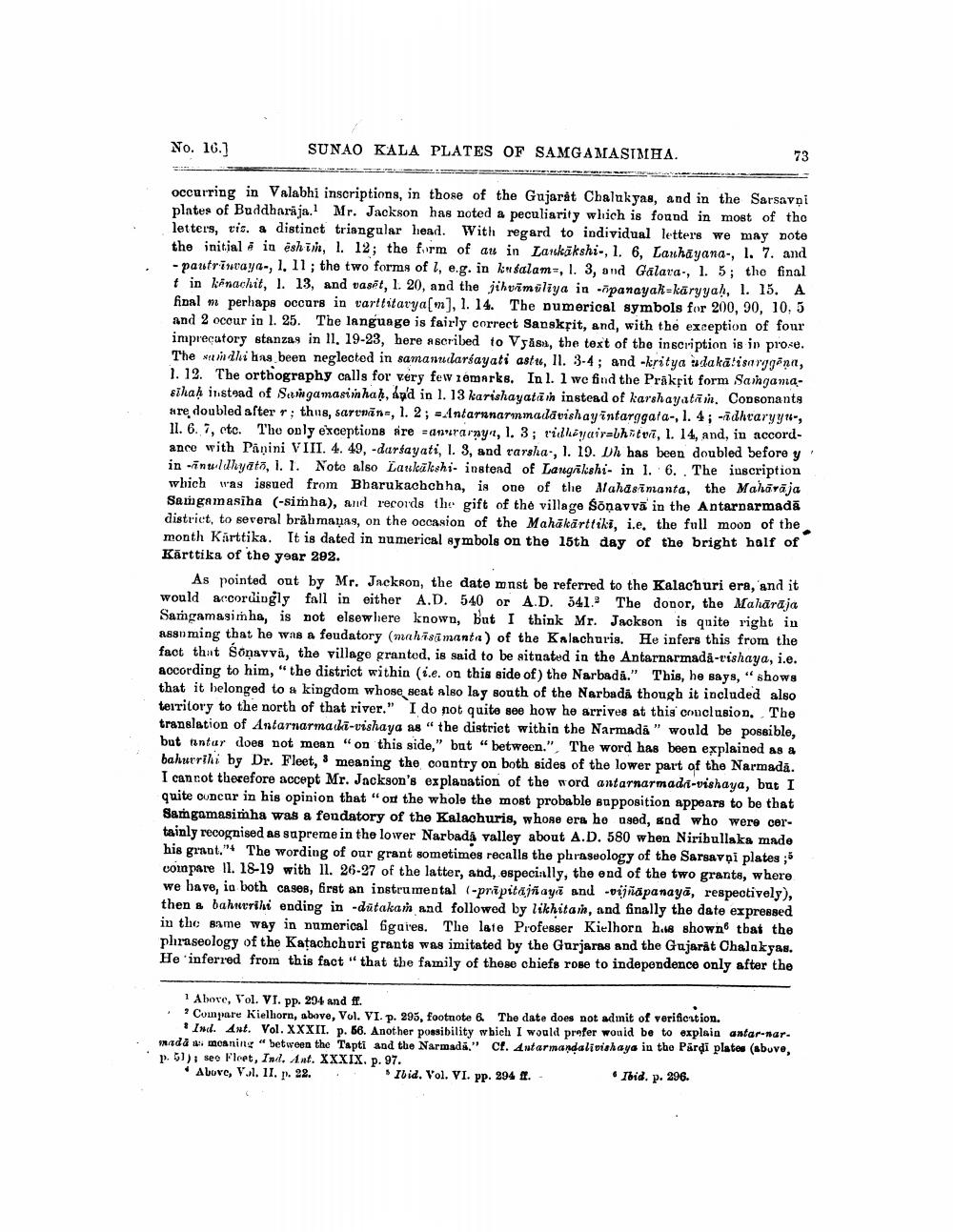________________
No. 16.)
SUNAO KALA PLATES OF SAMGAMASIMHA.
73
occurring in Valabhi inscriptions, in those of the Gujaråt Chalukyas, and in the Sarsavni plates of Buddharāja. Mr. Jackson has noted a peculiarity which is found in most of the letters, ris, a distinct triangular head. With regard to individual letters we may note the initial : in eshin, 1. 12; the form of au in Laukākshi-, 1. 6, Lauhayana-, 1. 7. and - pautriwaya-, 1, 11; the two forms of I, e.g. in ko salam, 1. 3, and Gálava-, l. 5; the final t in kinachit, l. 13, and vasit, 1. 20, and the jihvimüliya in -īpanayak-käryyah, I. 15. A final * perhaps occurs in varttitarya[m], 1. 14. The numerical symbols for 200, 90, 10,5 and 2 ocour in l. 25. The language is fairly correct Sanskpit, and, with the exception of four imprecatory stanzas in 11, 19-23, here ascribed to Visa, the text of the inscription is in proxe. The suidhi has been neglected in samanudarsayati astrs, II. 3-4 ; and -kritya udakātisarygana, 1. 12. The orthography calls for very few remarks. In l. 1 we find the Prakrit form Saigama. sihaḥ instead of Samgamasiinhaḥ, áp'd in l. 13 karishayata in instead of karshayatai. Consonants are doubled after r; thus, sarenāns, 1. 2; -Antaranarmmadāvishayintarggata., 1. 4; -7dhraryys-, 11. 6. 7, etc. The only exceptions are =anurarny, 1. 3; ridhiyair-bhitur, l. 14, and, in accordance with Panini VIII. 4. 49,-darsayati, I. 3, and rarsha., 1. 19. Dh has been doubled before y in inuildhyati, 1. 1. Noto also Laukākshi- instead of Langrikshi- in l. 6. . The inscription which tras issued from Bharukachchha, is one of the Alahasimanta, the Mahārāja Samgamasiha (-simha), and records the gift of the village sõnavvā in the Antarnarmadā district, to several brahmanas, on the occasion of the Mahākārttiki, i.e. the full moon of the month Kürttika. It is dated in numerical symbols on the 15th day of the bright half of Kārttika of the year 292.
As pointed out by Mr. Jackson, the date must be referred to the Kalachuri era, and it would accordingly fall in either A.D. 540 or A.D. 541. The donor, the Mahāraja Sangamasimha, is not elsewhere known, but I think Mr. Jackson is quite right in 1880 ming that he was a feudatory (mahisimanta) of the Kalachuris. He infers this from the fact that sõnavvā, the village granted, is said to be situated in the Antarnarmadā-rishaya, i.e. according to him, "the district within (ie, on this side of) the Narbada." This, he says, "shows that it belonged to a kingdom whose seat also lay south of the Narbada though it included also territory to the north of that river." I do not quite see how he arrives at this conclusion. The translation of Antarnarmacki-vishaya as "the distriet within the Narmada" would be possible, but tentar does not mean "on this side," but "between.". The word has been explained as a bahurrihi by Dr. Fleet, meaning the country on both sides of the lower part of the Narmada. I cannot therefore accept Mr. Jackson's explanation of the word antarnarmadi-vishaya, but I quite cuncar in his opinion that "on the whole the most probable supposition appears to be that Samgamasimha was a fendatory of the Kalachuris, whose era ho used, and who were certainly recognised as sapreme in the lower Narbadá valley about A.D. 580 when Niribullaks made his grant."4 The wording of our grant sometimes recalls the phraseology of the Sarsavși plates ; vonapare 11. 18-19 with 11. 26-27 of the latter, and, especinlly, the end of the two grants, where we bave, ia both cases, first an instrumental (-prēpitajtayi and -vijiapanaya, respectively), then & bahwerihi ending in -dutakaṁ and followed by likhitain, and finally the date expressed in the same way in numerical figaies. The late Professer Kielhora hus shown that the phraseology of the Katachchuri grants was imitated by the Gurjaras and the Gujarat Chalukyas. He inferred from this fact that the family of these chiefs rose to independence only after the
Abore, Vol. VI. pp. 294 and fr. • Compare Kielhorn, above, Vol. VI. p. 293, footnote & The date does not admit of verification.
Ind. Ant. Vol. XXXII. p. 56. Another possibility wbich I would prefer would be to explain antar-nar. • wadau moaning between the Tapti and the Narmadá." Cl. Autarmandaliviahaya in the Pardi plates (@buvo, * p. 57); see Fleet, Ind. Ant. XXXIX. p. 97. Above, Vol. II. p. 22. Ibid. Vol. VI. pp. 294 I..
• Ibid. p. 296.




